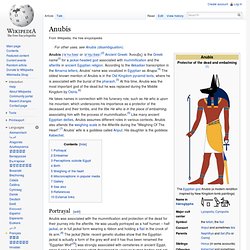

Anubis. Anubis (/əˈnuːbəs/ or /əˈnjuːbəs/;[2] Ancient Greek: Ἄνουβις) is the Greek name[3] for a jackal-headed god associated with mummification and the afterlife in ancient Egyptian religion.

According to the Akkadian transcription in the Amarna letters, Anubis' name was vocalized in Egyptian as Anapa.[4] The oldest known mention of Anubis is in the Old Kingdom pyramid texts, where he is associated with the burial of the pharaoh.[5] At this time, Anubis was the most important god of the dead but he was replaced during the Middle Kingdom by Osiris.[6] He takes names in connection with his funerary role, such as He who is upon his mountain, which underscores his importance as a protector of the deceased and their tombs, and the title He who is in the place of embalming, associating him with the process of mummification.[5] Like many ancient Egyptian deities, Anubis assumes different roles in various contexts.
Portrayal[edit] Embalmer[edit] Perceptions outside Egypt[edit] Rush - Between Sun & Moon. Horus. Horus is one of the oldest and most significant deities in ancient Egyptian religion, who was worshipped from at least the late Predynastic period through to Greco-Roman times.

Different forms of Horus are recorded in history and these are treated as distinct gods by Egypt specialists.[1] These various forms may possibly be different perceptions of the same multi-layered deity in which certain attributes or syncretic relationships are emphasized, not necessarily in opposition but complementary to one another, consistent with how the Ancient Egyptians viewed the multiple facets of reality.[2] He was most often depicted as a falcon, most likely a lanner or peregrine, or as a man with a falcon head.[3] Etymology[edit]